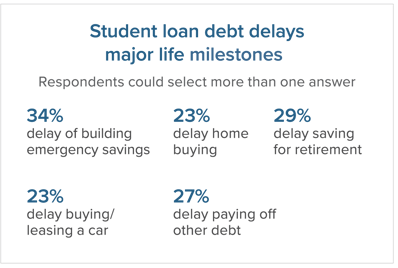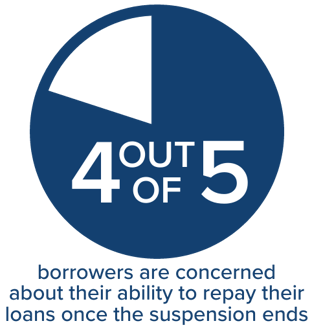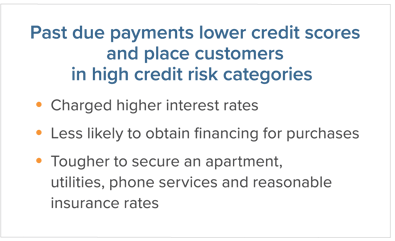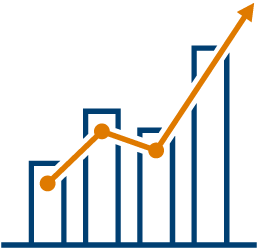Student Loan Stats
Millions of Americans have student loan debt
People experience their student loan debt in different ways. It may cause mild anxiety for some or be a huge stressor for others. Student loans are the second-highest consumer debt category in the US, so the impacts on individuals and the economy are huge. For example, employers have reported that workers with student loan stress have reduced workplace productivity and engagement.
These statistics are meant to help paint a picture of the situation. A situation that can be improved by a collective response from employers, financial institutions, and member organizations who are willing to provide student loan support. The Attigo Suite can help make it happen.
Student Loan Debt, Demographics
- There is $1.71 trillion in student loan debt in the US and it grows 6X faster than the nation’s economy. (Federal Reserve, Education Data)
- $33,900 is the average student loan debt at non-profit private colleges and universities. (NCES)
- Student loan debt by age group & average amount:
Millennials 30-44 years old 49% = $40.2K;
Gen X 45-59 years old 15% = $39.7K;
Baby Boomers & Silent Gen 60-99 years old 2% = $35.4K & $24.3K respectively
Gen Z 18-29 years old 34% = $16.5K. (Education Data) - 93% of student loan debt holders report borrowing for their own education, and 81% report borrowing for a child’s or grandchild’s education. (Federal Reserve)
- 64% of indebted student borrowers are between the age of 25 and 50. (Federal Student Aid)
Economic Impacts
 Nearly 73% of Millennials, 62% of Gen X, and 50% of Baby Boomers with student loan debt have delayed at least one major life or financial milestone, as a result they’re unable to engage in financial milestones like purchasing a car, buying a home, or having children. (Bankrate - opposing image)
Nearly 73% of Millennials, 62% of Gen X, and 50% of Baby Boomers with student loan debt have delayed at least one major life or financial milestone, as a result they’re unable to engage in financial milestones like purchasing a car, buying a home, or having children. (Bankrate - opposing image)- A $1,000 increase in student loan debt can cause a 1-2% drop in home ownership, according to the Federal Reserve Board. (Fox)
- 53% of millennials haven't purchased a home due to student loan debt either disqualifying them or making it impossible to afford a mortgage. (Education Data)
COVID's Impact
 3.2 million new federal student loan borrowers and an unemployment spike fueled the biggest increase in total student loan debt since 2013. (Education Data)
3.2 million new federal student loan borrowers and an unemployment spike fueled the biggest increase in total student loan debt since 2013. (Education Data)- 79% of student loan borrowers have challenges that will impact their ability to pay once the CARES Act suspension period ends (e.g., unemployment, underemployment, illness, deferment, etc.). (Ascendium)
- Total student loan debt increased 8.28% in 2020; while average student loan debt increased 4.5%. (Education Data)
- Only 50% of those who had lost their job during the pandemic had secured a new position. (Vox)
- 62% of employers in 2020 (up from 13% in 2013) feel extremely responsible for their employees’ financial wellness. (Bank of America)
- 11.2% of adults with student loan debt said they were unable to make at least one student loan payment year-to-date, reported in July 2020. (Education Data)
Financial Stress In the Workplace
 4 out of 5 employers say employees' personal finance issues impact job performance. (IFEBP)
4 out of 5 employers say employees' personal finance issues impact job performance. (IFEBP)- 49% of struggling employees reported suffering from stress, anxiety or depression over the past 2 years, compared to just 16% of employees with no financial worries; and, only 39% of struggling employees were fully engaged at work. (Willis Towers Watson)
- 53%+ Americans agree that thinking about their finances makes them anxious. (US Financial Capability)
- 38% of employees have less than $1,000 saved to deal with unexpected expenses. (Price Waterhouse Cooper)
- Financially stressed employees are 3X more likely to be disengaged than their counterparts. (Willis Towers Watson)
- Financially stressed employees miss 2X as many days a year compared to unstressed peers. (ADP)
- 67% of Millennials and 32% of Baby Boomers said their financial stress hinders their focus and productivity at work. (Bank of America)
- 76% of Millennials, 68% of Gen X and 57% of Baby Boomers said they’ve used financial services provided by their employer to assist them with their personal finances. (Price Waterhouse Cooper)
- 47% of Millennials are afraid they'll be unable to meet their families’ basic financial needs when they retire. (Transamerica Center for Retirement Studies)
- When asked what causes the most stress, 54% reported financial or money matters/challenges. (Price Waterhouse Cooper)
Financial Wellness in the Workplace
 80% of employers (from large and small companies) believe employee financial wellness programs help produce employees who are more loyal, productive, satisfied, and engaged. (Bank of America)
80% of employers (from large and small companies) believe employee financial wellness programs help produce employees who are more loyal, productive, satisfied, and engaged. (Bank of America)- 47% of Gen Z and Millennial employees feel there is a lot more their employer can do to support overall holistic well-being (financial, physical, mental). (Bank of America)
- 83% of HR professionals say financial stress in employees has a negative impact on work performance. (SHRM)
- Financial health programs have been shown to reduce absenteeism, improve productivity and lower health care costs. (ADP)
- Nearly 50% of organizations rate their workforce as not at all/only a little bit financially savvy. (SHRM)
- 62% of employers feel extremely responsible for their employees' financial wellness, up from 13% in 2013. (ebn)
- 69% of employees who were given access to 4 or more tools and resources (the most) reported their finances were headed in the right direction versus 51% who had no access to tools and resources. (Willis Towers Watson)
- 64% of employees with the most access reported being encouraged to improve their financial situation versus 40% with some access. (Willis Towers Watson)
- 75% of millennials, 75% of Gen S and 85% of baby boomers say they have a good understanding of employer benefit and savings plans and the role those plans play in their overall financial well-being. (Price Waterhouse Cooper)
- 83% of employers believe financial wellness tools lead to greater productivity. (Bank of America)
- 56% of employers offer tuition assistance in the form of reimbursement, which is tax-exempt for employees up to $5,250/year. (SHRM)
Student Loan Delinquency & Default
 First-generation college students are 2X as likely to report being behind in making student loan payments. (Education Data)
First-generation college students are 2X as likely to report being behind in making student loan payments. (Education Data)- 1 out of 5 student loan borrowers experience student loan default and its life-long consequences. (PEW)
- Consequences of default can include high collection fees, wage garnishment, credit score damage, withholdings from income tax refunds and Social Security. (PEW)
- The default rate among Black graduates is more than 5X the rate of White counterparts. (Brookings)
- 25% of student loan borrowers default within the first 5 years of repayment. (Education Data)
- 78% of the borrowers who have defaulted owe $40,000 or less. (Education Data)
- 30% of Black college graduates with student loans default within the first 12 years of repayment. (Education Data)
Borrowers Need Support
 40%+ of workers said the most valuable resource their employer could provide to help them reach their financial goals, would be advice from a financial professional. (Bank of America)
40%+ of workers said the most valuable resource their employer could provide to help them reach their financial goals, would be advice from a financial professional. (Bank of America)- 51%+ student loan borrowers say they did not estimate monthly payments when obtaining their most recent student loan. (US Financial Capability)
- 52% of student loan borrowers who are satisfied with their loan servicer(s) go elsewhere for loan information. (Ascendium)
- $26.9 million of the $700 million allocated for Public Service Loan Forgiveness (PSLF) program was approved by the Department of Education. (Education Data)
- A little over 1% of PSLF applications have been approved since the program’s inception. (Education Data)
- 25%+ of the US labor force is in public service; 3 million are eligible to apply for PSLF, but just over 200,000 have applied. (Education Data)
- 79% of student loan borrower respondents said they would utilize a trustworthy and established student loan counseling service if one was offered by their school, bank or employer. (Ascendium)
- 52% don't know what their monthly payment will be once the CARES Act suspension ends; 33% don't know what repayment plan they'll use; and, 63% don't know how to implement an alternative plan. (Ascendium)
- 33% of first-generation students quit college within 3 years. (Hechinger Report)
Attract & Retain Employees
 The number of US employers offering student loan assistance has doubled since 2018. (SHRM)
The number of US employers offering student loan assistance has doubled since 2018. (SHRM)- 40% of Millennials say they're "somewhat committed" to their employer. (ReportLinker)
- 35% of Millennials and 27% of all other age groups have turned down job offers due to dissatisfaction with the benefits (Anthem)
- 55% of Millennials and 35% of workers in general rank student loan repayment assistance as a top demanded employee perk (Unum)
- 80% of Millennials would strongly consider a job with a student loan repayment benefit over one without it. (Forbes)
- 86% of employees with student loans would commit to a company for 5 years if the employer helped pay back their student loans. (SHRM)
- 70% of employees with debt said student loan benefits would improve their work performance. (US News)
-
62% of Millennials are more likely to say their company loyalty is influenced by how much the company cares about their financial well-being; as compared to Gen X (50%) and Baby Boomers (36%). (Price Waterhouse Cooper)
- 72% of Millennials and 71% of Gen X are more likely than Baby Boomers (45%) to be attracted to another company that cares more about their financial well-being. (Price Waterhouse Cooper)
Attigo Brochure Sources
- 80% of employees spend 12-20 hours/month dealing with their financial stressors at work. (Corporate Wellness)
- 64% of adults feel a lot of stress or some stress about undergraduate student loan debt. (Morning Consult)
- 70% of student loan borrowers feel student loans have a moderate to significant impact on their ability to meet their financial goals. (Price Waterhouse Cooper)
- Average student loan debt by generation: Gen Z $16.5K; Millennials $40.2K; Gen X $39.7K; Baby Boomers $35.4K; Silent Gen $24.3K. (Education Data)
- The default rate among Black graduates is more than 5X the rate of White counterparts. (Brookings)
- 1 out of 5 student loan borrowers experience student loan default and its life-long consequences. (studentaid.gov)
- Consequences of default can include high collection fees, wage garnishment, credit score damage, withholdings from income tax refunds and Social Security. (Ascendium)
- 80% of millennials would strongly consider a job with a student loan repayment benefit over one without it. (Forbes)
- 86% of employees with student loans would commit to a company for 5 years if the employer helped pay back their student loans. (Society for Human Resources Management)
- Financially stressed employees are 3X more likely to be disengaged than their counterparts. (Willis Towers Watson)
- 70% of employees with debt said student loan benefits would improve their work performance. (CommonBond)
Find additional resources on our Student Loan Repayment Benefit page.